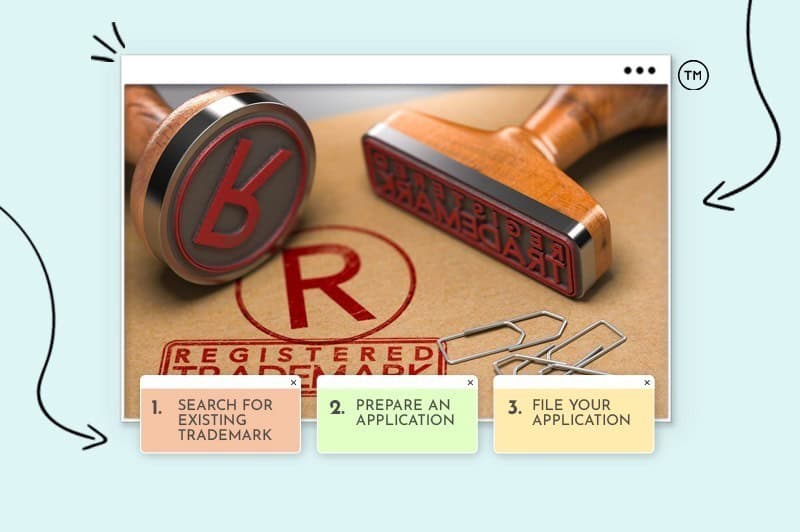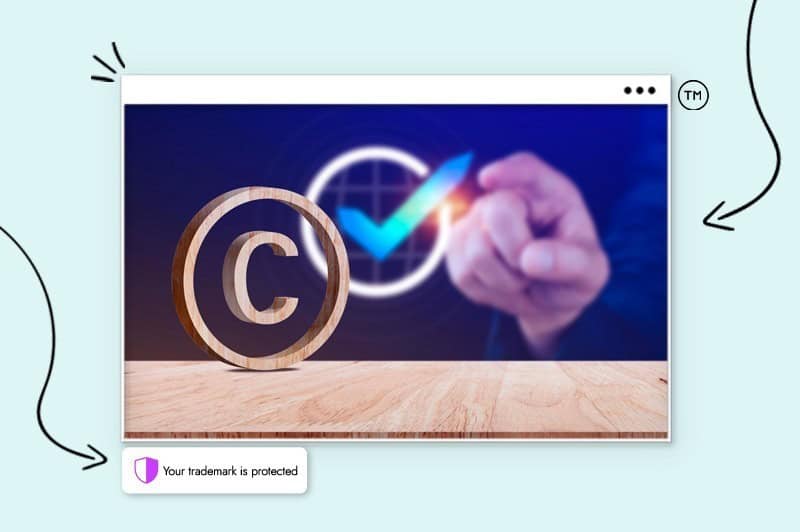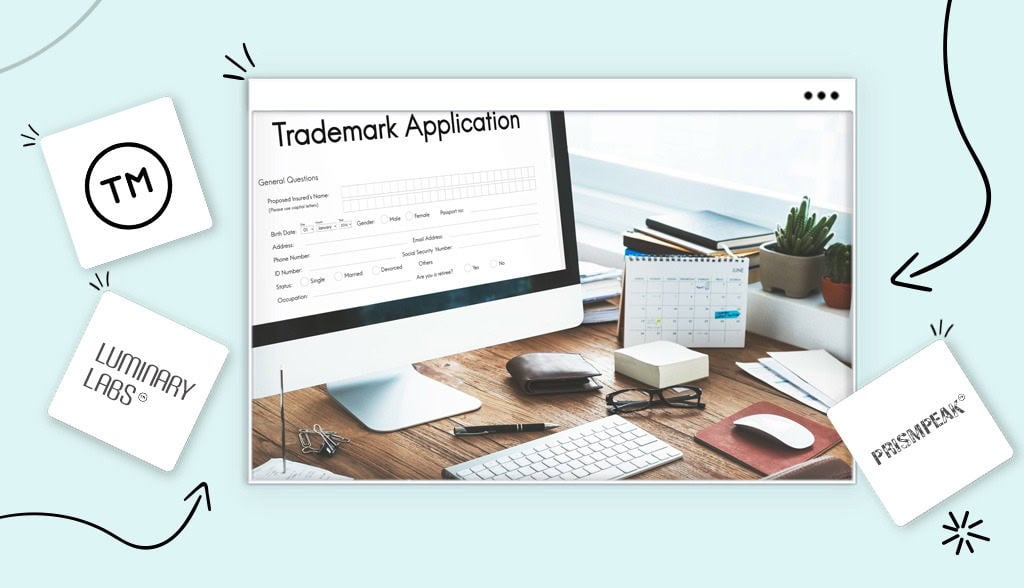You’ve worked hard choosing a business name that encapsulates your brand’s essence, engages your target audience’s attention, and connects with their emotions to sell your products or services.
That’s why you must protect it, and you can by registering a trademark.
But the registration process isn’t easy, and if you get it wrong, the United States Patent and Trademark Office might deny your mark, which could cost you the application fee.
This post will tell you how to prepare your application and file it, why USPTO might deny it, what to do if that happens, and what `re the steps you must take after you get trademark approval.
What is a Trademark?

A trademark is a symbol, word, phrase, or combination that identifies and distinguishes a brand’s products or services from another’s. It’s like a signature that protects your intellectual property and prevents unscrupulous types from stealing your ideas or using similar marks that could confuse consumers.
For example, you’ve got a memorable name, “Wok this way,” for your new Asian-inspired food truck business. It’s perfect, works on all your branding platforms, and people love it.
To own that name and stop anyone from using it, you must register a trademark with the United States Patent.
The differences between a trademark, patent, and copyright
Trademarks, patents, and copyrights all fall under the Intellectual property umbrella, but they protect different things.
Here’s a quick explanation:
Trademark
A trademark stops anyone else from using a symbol, word, or phrase (like your logo or business name) you used to promote your products or services.
Once you own a trademark and continuously use it, you can renew it indefinitely.
Patent
Patents protect inventions, giving holders the exclusive right to make, use, and sell them for a certain period.
Patent protection lasts for 20 years from the filing date.
Copyright
Copyrights protect the arts, like books, movies, or songs.
It protects the expression rather than the concept itself, so while you can’t copy a work, you could create something similar in your style.
Copyright is a little ambiguous, as Pharrell Williams and Ed Sheeran found out!
Registration is automatic, but registering a copyright can provide additional legal protections.
Key differences:
Trademarks protect brand identities, patents protect inventions, and copyrights protect creative works.
What is common law ownership?
Common law ownership refers to gaining ownership of a trademark through use in commerce.
For example, you come up with the business name “Sip Happens” for your new coffee shop and run it locally for several years. Even though you never trademark your business name, you have common law ownership, giving you legal rights in your area.
While common law ownership allows you to gain trademark rights through use, registration provides national legal protection for your business and brand identity.
What are trademark classes?
Trademark classes are how the USPTO categorizes different products and services. There are 45 that cover everything from clothing to financial services.
When registering your trademark, you must choose the class relative to your product or service. And you must get this right because you could lose your protection from infringement if you choose the wrong class.
It sounds easy enough. But trademark classes are confusing, and it’s where many applications go wrong. So, take your time with this step and learn what you need before applying.
In a nutshell:
Trademark classes are categories of products and services used for trademark registration. Choosing the right classes is essential to protect your trademark in the areas where your brand does business.
How to decide if you need a trademark
Take our “Sip Happens” coffee shop example; if you aren’t planning on expanding to other states, you might not need a trademark.
But, chances are, most businesses do, especially if you answer yes to these questions:
- Is your brand name, logo, or slogan crucial for promoting your business?
- Do you sell products or services?
- Might you expand your business in the future?
- Are you concerned about the risk of infringement or copycats?
The takeaway:
If you want to protect your branding, trademark your intellectual property.
What are the benefits of trademarking a business name?

There aren’t many things you can buy for $350 (the average registration fee) that provide the same value as a trademark.
Here are 10 ways a trademark can help your business:
Prevent legal action
Trademarking your business name can prevent others from using it or something similar, which can help you avoid legal action such as infringement lawsuits.
Universal protection across the U.S.
USPTO trademark registration protects your business name throughout the United States on a federal level. Stopping anyone else from using your business name or anything similar for the same products or services without your permission.
Counterfeit protection
Trademarking your business name can help prevent counterfeit products from entering the market. And if someone sells fake products using your business name, you can sue them.
Brand recognition
Think of a brand, any brand; what image came to mind?
For example, if I think of Nike, a swoosh appears; Micky Dee’s and its golden arches.
Sure, they’re global businesses, but brand recognition works on every level.
Competitive advantage
When you trademark your business name and secure the domain across all social media, you create consumer awareness, giving you the upper hand over your competitors.
Value
Anything your business owns can increase its value; your intellectual property is part of that portfolio, especially if you want to sell.
Attract investors
A trademark can also attract investors by providing a valuable asset that differentiates your business from competitors, creating customer loyalty and leading to increased revenue and long-term growth.
Allowed to use the ® symbol
Trademark registration allows you to use the ® symbol, warning others that using your trademark without your permission may cause legal action.
How to Trademark a Business Name in 3 Steps

1. Search for existing trademarks
When registering a trademark, you must search for existing marks to avoid potential legal disputes or infringement claims. And to ensure your application gets approval, as fees are non-refundable!
Begin your search using the USPTO’s Electronic Search System (TESS).
It’s an online database that helps you search for trademarks already in use or pending registration. You can search for marks by keyword, trademark owner name, or trademark registration number.
And could also increase your search to include other countries, like:
Besides using TESS, you can also search at the Patent and Trademark Resource Center. And finish with a “common law search” to identify unregistered trademarks.
Here are some relevant steps and sources to see if similar marks are in use:
- Perform a Google search to see if your proposed name is already in use online.
- Check the “Internet Corporation for Assigned Names and Numbers” (ICANN) to ensure your business name’s available as a domain.
- Search social media using tools like Namechk to see if your name is already in use.
- Check your state’s Secretary of State business search website to see if your business name is locally used.
- And Super Pages to determine if certain listings are already in use.
And the USPTO provides tons of helpful information on its TESS TIPS website page.
2. Prepare your application
Applying for a trademark takes work; go slow and triple-check everything before submitting your application; and review the USPTO trademark basics page before you begin.
Here’s a quick run-through of what the application requires:
- Your personal information: Your name and address if applying as an individual.
- Citizenship: Your citizenship and legal entity if you have one.
- Details about your business: Your legal business name and location. (None U.S. residents must hire a lawyer to file for them).
- Your marks’ description: Include a drawing of your mark, or if you aren’t including a design element, your business name.
- What it covers: A list describing the goods or services you want to cover with your trademark application.
- Determine the type of trademark application: You have 2 choices when applying, a standard application and an intent-to-use application.
Standard applications are for business names already in use in commerce, and intent-to-use applications are for a business you plan to use in the future. - Identify the basis for your application: You must identify the basis for your trademark application, including actual use in commerce, intent to use in business, or foreign registration.
- Choose the correct trademark class: The USPTO classes all trademarks relative to the goods or services they represent. And you must choose the correct trademark class or classes for your mark/marks; otherwise, the USPTO will refuse your application.
- Date and signature: Either you or an authorized representative must sign and date the application.
- The fee: Ensure you pay the correct fee for your chosen class or classes.
The USPTO also provides an online step-by-step guide to help you through the application process.
3. File your application
You’ve 3 options when submitting your trademark application with the USPTO:
- Online: Using the USPTO Trademark Electronic Application System (TEAS).
- Mail: By mail at the Commissioner for Trademarks, P.O. Box 1451, Alexandria, VA 22313-1451.
- Fax: If you can find a fax machine, send it to (571) 273-0110.
A quick word about TEAS:
The Trademark Electronic Application System (TEAS) has two filing options:
TEAS Plus is cheaper, but you must use a standard description from the Trademark ID manual. If you want to write a description, you must use the Standard TEAS application.
Price and application length
The filing cost for a trademark application varies depending on the TEAS option selected. TEAS Plus costs $250, and TEAS Standard costs $350, but additional fees may apply for multiple classes or marks.
What should you expect after filing?
When you submit your trademark application, a USPTO examining attorney reviews it. If any issues arise, you’ll receive an Office action letter explaining the problem and granting you around 6 months to respond. It’s essential to respond to Office actions within this time frame because failing to do so will cause the denial of your application.
Assuming your application meets all the requirements and receives approval, the USPTO will publish it in the Trademark Official Gazette, allowing others to oppose it. If someone does, you may need legal help to address the challenge.
After submitting, check your application status on the Trademark Status and Document Retrieval (TSDR) system every three to six months to ensure you meet all deadlines. And expect a response within three months, but applications can take longer.
What are the common reasons the USPTO rejects a trademark?
The bad news is that the USPTO can reject your trademark application; here are the main reasons:
- Similar to an existing trademark: While the USPTO won’t accept applications that are too similar to existing trademarks, you might get approval if the other business name is in an unrelated market.
- Generic or descriptive: The USPTO does not grant trademarks that are too generic or descriptive. For example, you cannot trademark “apple” for apples
- Your trademark breaks ethical codes: Trademarks that are immoral or scandalous will not get approval.
- A geographical name: The USPTO might deny your application if it comprises a geographical term.
- A functional trademark: If your mark is functional, meaning it’s necessary for the product or service’s function, expect rejection.
Additional help from the USPTO:
Although the USPTO website and staff can help you with the trademark application process, consider consulting a trademark lawyer if in doubt.
If a lawyer is outside your budget, don’t worry, the USPTO website has a ton of information. It’s easy to navigate and provides simple explanations of what to expect.
What happens once registration is complete?

After you submit your application and receive approval, the USPTO will send you a certificate confirming your trademark protection.
But that’s not the end of the journey; now you have to protect and renew your trademark:
Protect your trademark
Protecting your trademark, also known as maintaining, means ensuring no other business uses it without your permission. If you don’t, you could lose it.
It comes back to the “common law use” we looked at earlier in the post.
Also, if your mark becomes too generic, meaning we use it to refer to a type of product or service rather than your specific brand (like Velcro and Thermos), you may lose protection. But if that happens, odds are you’ll have already made your fortune!
How to protect your trademark
Monitor your marketplace and look for any other brand using your business name; if you find one, take immediate legal action and send a cease-and-desist letter or sue for trademark infringement.
Key takeaway: You could lose your trademark if you don’t protect it.
Trademark renewal
Renewing your trademark every 10 years (or as required by your country) is crucial for protecting your brand identity. Failing to renew it can lead to cancellation or expiration, making your brand vulnerable to infringement.
To renew your trademark, file a renewal application with USPTO, provide basic information about your mark and confirm you’re still using it.
Renewing your trademark maintains its registration and legal protections. Keep track of your trademark renewal deadlines and file the paperwork on time to safeguard your brand identity.
Conclusion
Securing your trademark is an investment in your business’s long-term success and growth, and that’s always worth the effort.
Because when you trademark your business name, you own another piece of your visual identity.
And when you add that to your logo, you can create a successful brand that consumers recognize and trust.
FAQ
A trademark is a word, phrase, symbol, or design that identifies and distinguishes your brand’s products or services from others and protects your intellectual property.
Not necessarily, using a name in commerce can give you limited “common law” rights, but registering a trademark provides nationwide legal protection.
Trademarks protect brand identifiers, patents protect inventions, and copyrights protect creative works like books, music, and films.
Common reasons include similarity to an existing trademark, being too generic or descriptive, using geographic terms, or being considered immoral or functional.
You’ll receive a registration certificate, but you must actively protect your trademark and renew it on time to maintain legal protection.
